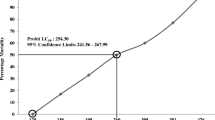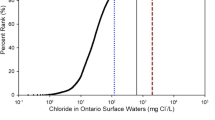Abstract
The 96-h lethal tolerance limits of the hard clam Mercenaria mercenaria (Linné) and the oyster Crassostrea virginica (Gmelin) to ammonia, nitrite ion, nitrate ion, and orthophosphate were defined. Sublethal effects of the chemicals upon the rates at which the shellfish removed algal cells from suspension were also studied. In comparison with other marine and aquatic species which have been studied, hard clams and oysters are extremely tolerant.
Similar content being viewed by others
Literature Cited
American Public Health Association: Standard methods for the examination of water and wastewater, 874 pp. 13 ed. New York: American Public Health Association 1971
Becker, C.D. and T.O. Thatcher: Toxicity of power plant chemicals to aquatic life. U.S. Atomic Energy Commission, Publ. 1249, 218 pp. (1973)
Chanley, P.E.: Survival of some juvenile bivalves in water of low salinity. Proc. natn. Shellfish. Ass. 48, 52–65 (1957)
Collier, A.: A study of the response of oysters to temperature and some long range ecological interpretations. Conv. Addr. natn. Shellfish. Ass. 1953, 13–38 (1954)
Daugherty, F.M., Jr.: Effects of some chemicals used in oil well drilling on marine animals. Sewage ind. Wastes 23, 1282–1287 (1951)
Davis, H.C.: Effects of turbidity-producing materials in seawater on eggs and larvae of the clam (Venus mercenaria). biol. Bull. mar. biol. Lab., Woods Hole 118, 48–54 (1960)
—: Effects of some pesticides on eggs and larvae of oysters (Crassostrea virginica and clams Venus mercenaria). Comml Fish. Rev. 23, 8–23 (1961)
Dowden, B.F. and H.J. Bennet: Toxicity of selected chemicals to certain animals. J. Wat. Pollut. Control Fed. 37, 1308–1316 (1965)
Downing, K.M. and J.C. Merkens: The influence of dissolved oxygen concentration on the toxicity of un-ionized ammonia to rainbow trout (Salmo gairdnerii Richardson). Ann. appl. Biol. 43, 243–246 (1955)
Dunstan, W.M. and D.W. Menzel: Continuous cultures of natural populations of phytoplankton in dilute, treated sewage effluent. Limnol. Oceanogr. 16, 623–632 (1971)
Epifanio, C.E., G. Pruder, M. Hartman and R. Srna: An interdisciplinary study on the feasibility of recirculating systems in mariculture. Proc. Wld Maricult. Soc. 4, 37–52 (1974)
—, R. Srna and G. Pruder: Mariculture of shellfish in controlled environments: a prognosis. Aquaculture 5, 227–241 (1975)
Fingerman, M.: Effects of temperature and salinity on ciliary activity in the oyster Crassostrea virginica. Comml Fish. Rev. 21, 10–11 (1959)
Galstoff, P.S.: The American oyster. Fish. Bull. U.S. 64, 1–480 (1964)
Loosanoff, V.: Some aspects of behavior of oysters at different temperatures. Biol. Bull. mar. biol. Lab., Woods Hole 114, 57–70 (1958)
— and P.B. Smith: Some aspects of behavior of oysters accustomed to different salinities. Anat. Rec. 105, p. 627 (1949)
Medcoff, J.C. and A.W.H. Needler: The influence of temperature and salinity on the condition of oysters (O. virginica). J. Fish. Res. Bd Can. 5, 253–257 (1941)
Patrick, R., J. Cairns, Jr. and A. Scheier: The relative sensitivity of diatoms, snails and fish to twenty common constituents of industrial wastes. Progve Fish Cult. 30, 137–140 (1968)
Pratt, D.M. and D.A. Campbell: Environmental factors affecting growth in Venus mercenaria. Limnol. Oceanogr. 1, 2–17 (1956)
Spotte, S.H.: Fish and invertebrate culture, water management in closed systems, 160 pp. New York: Wiley Interscience 1970
Srna, R., C. Epifanio, G. Pruder, M. Hartman and A.S. Baggaley: The use of ion specific electrodes for chemical monitoring of marine systems. Part I. The ammonia electrode as a sensitive water quality indicator probe for recirculating mariculture systems. University of Delaware Sea Grant Publication DEL. SG-14-73 20 pp. (1973). (Internal publication)
Strickland, J.D.H. and T.R. Parsons: A practical handbook of seawater analysis. Bull. Fish. Res. Bd Can. 167, 1–311 (1968)
Warren, K.S.: Ammonia toxicity and pH. Nature, Lond. 195, 47–49 (1962)
Author information
Authors and Affiliations
Additional information
Communicated by M.R. Tripp, Newark
Rights and permissions
About this article
Cite this article
Epifanio, C.E., Srna, R.F. Toxicity of ammonia, nitrite ion, nitrate ion, and orthophosphate to Mercenaria mercenaria and Crassostrea virginica . Marine Biology 33, 241–246 (1975). https://doi.org/10.1007/BF00390928
Accepted:
Issue Date:
DOI: https://doi.org/10.1007/BF00390928




